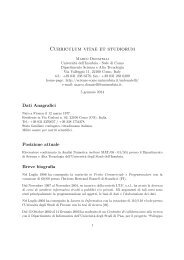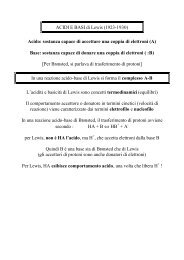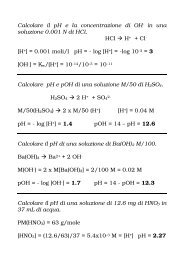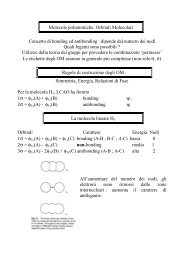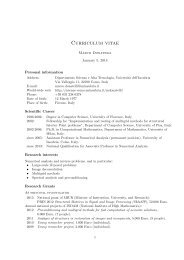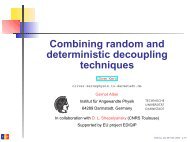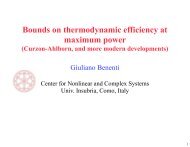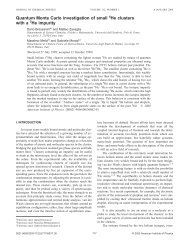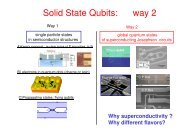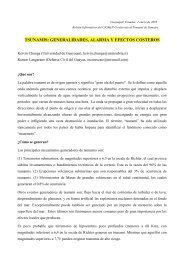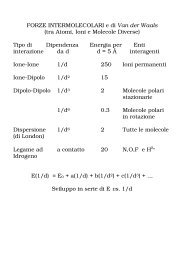Create successful ePaper yourself
Turn your PDF publications into a flip-book with our unique Google optimized e-Paper software.
<strong>Quantum</strong> <strong>computation</strong> <strong>with</strong> <strong>trapped</strong> <strong>ions</strong><strong>Quantum</strong> computing …• Fundamentalsion ion traps, quantum bits, quantum gates• Experiments2-qubit gates, teleportation, recent progress• FutureQC QC architecture; qubit interfacingJ. EschnerICFO – Institut de Ciències Fotòniques, Barcelona, SpainInstitut für Experimentalphysik, U Innsbruck, AustriaApplicat<strong>ions</strong> in informatics and physics• P. Shor, 1994: factorization of large numbers is polynomial on aquantum computer, exponential on a classical computer• L. Grover, 1997: data base search N 1/2 quantum queries, N classical• simulation of Schrödinger equat<strong>ions</strong> or any unitary evolution• quantum cryptography / repeaters / quantum links• improved atomic clocks• understanding the fundamentals of quantum mechanics /Gedanken-Experimente• Experiments <strong>with</strong> entangled matterVarenna, 12 - 13 July, 2005Progress in technology ...Various approachesHow many atoms per bit?• Ion traps• Neutral atoms in traps (opt. traps, opt. lattices, microtraps)ENIAC (1947)Pentium 4 (2002)number of atoms per bit1910151011107103100101 atom per bit~ 20171960 1970 1980 1990 2000 2010 2020year• Neutral atoms and cavity QED• NMR (in liquids)• Superconducting qubits (charge-, flux-qubits)• Solid state concepts(spin systems, quantum dots, etc.)• Optical qubits and LOQC (linear optics quantum <strong>computation</strong>)• Electrons on L-He surfaces• Spectral hole burning in ion-doped crystals• …and more200 nm1 atom(design : R. Blatt)1
Single <strong>trapped</strong> and laser-cooled <strong>ions</strong> ...... are cold (< 1 mK) and well-localized (< 20 nm) Application for precision measurements and frequency standards(work by NIST, PTB, MPQ, NRC, NPL, NML, Mainz, MIT, ...)... are individual quantum systems Textbook experiments on fundamental quantum mechanicsIon traps(work by NIST, Innsbruck, MPQ, Seattle, IBM, Hamburg, ...)......allowallowfullfullcontrol,control,manipulationmanipulation andandmeasurementmeasurementofofquantumquantumstatestate(”quantum(”quantumstatestateengineering”)engineering”)ApplicationApplicationforforstudiesquantumofinformationentanglementprocessingand decoherenceandandstudiesfor quantumof entanglementinformationand decoherenceprocessing(work by NIST, Innsbruck, Hamburg , Oxford, MPQ, Michigan, ICFO)(work by NIST, Hamburg , Oxford, MPQ, Ibk, ...)Classic Paul trapIon storageendcapelectrodezlensfluorescencedetectionion confinement requires a focusing force in 3 dimens<strong>ions</strong>r r r r rr 2binding force F ~ −, that is F = eE = −e∇Φ ⇒ Φ ~ quadrupole potentialΦ0 2 2 2Φ = ( x + y − 2z)2r0(saddle potential)ringelectrodexendcapelectrodecoolingbeamyPaul trap:Φ = U V cosξt (Penning trap: = +0 0+0Φ0 U axial magn. field)0ξ42equation of motion in a Paul trap: && x + ( a − 2qcosξt)x = 0a ~ U V0, q ~frequencies of secular motion:superimposed is micromotion <strong>with</strong>:0ωx,ωy,ωzξMATHIEU EQUATION2ω ≈ ( a + 1q )ξ22
Ion trajectory in a Paul trapLinear ion traps1D-solution of Mathieu equat<strong>ions</strong>ingle Al dust particle in trapPaul mass filterposition in trapInnsbruckLos Alamossecular motion at ωtimemicromotion at ξWuerker, Shelton, Langmuir,J. Appl. Phys. 30, 342 (1959)Secular motion = harmonic oscillator <strong>with</strong> frequency ωBoulder, Mainz, AarhusBoulderMünchenThe prototypeString of 40 Ca+ <strong>ions</strong> in a linear Paul trapRow of ion-qubits in alinear Paul trap formsa quantum register70 µmH.C. Nägerl et al., Appl. Phys. B 66, 603 (1998); first ion strings: NIST, MPQH.C. Nägerl et al., Appl. Phys. B 66, 603 (1998)3
Qubits in <strong>trapped</strong> <strong>ions</strong> (two-level systems, TLS)Encoding of quantum information requires longlived atomic states:Single quantum systems - Qubits• optical transit<strong>ions</strong>(forbidden transit<strong>ions</strong>,intercombination lines)S – D transit<strong>ions</strong> in earth alkalis:Ca + , Sr + , Ba + , Ra + , (Yb + , Hg + ) etc.Innsbruck• microwave transit<strong>ions</strong>(Hyperfine transit<strong>ions</strong>,Zeeman transit<strong>ions</strong>)earth alkalis:9Be + , 25 Mg + , 43 Ca + , 87 Sr + ,NIST 137Ba + , 111 Cd + , 171 Yb +P 1/2D 5/2S 1/2P 3/2TLSS 1/2TLSLevel scheme of 40 Ca + S 1/2Zeeman structure of the S 1/2–D 5/2transitionP 3/2τ ≈ 8 ns854 nmP 1/2866 nmD 5/2τ ≈1 s393 nm 397 nmD 3/2Zeeman structure in non-zero magnetic field::D 5/25/23/21/2-/2 1-3/2-5/22-level-system1/2 ⇔ 5/2729 nm(electric quadrupole)S 1/2-/2 11/2∆S 1/24
Qubit transitionDiscrimination of qubit statesSuperposit<strong>ions</strong> of S 1/2(m=1/2) and D 5/2(m=5/2) forms qubitState detection by photon scattering on S 1/2to P 1/2transition at 397 nmP 3/2Manipulation by laser pulseson 729 nm transition(~ 1 ms coherence time)P 3/2τ ≈ 8 nsPhotons observed : S 1/2= |S>No photons : D 5/2= |D>P 1/2D 3/2τ ≈1 s729 nmqubit|D 5/2 (m=5/2)>P 1/2 qubit866 nmD 5/2 |D>τ ≈1 s397 nmD 3/2DetectorS 1/2|S 1/2 (m=1/2)>S 1/2S 1/2|S>State detection: <strong>Quantum</strong> jumpsQuantized motionPmonitorDSimultaneous cw excitation: absorption andemission cause fluorescence steps(digital quantum jump signal)Fluorescence intensityStime (s)SDAnzahl # of measurementsder Messungen8D-Zustand D state occupied besetzt7654321Histogram of counts per 9 msPoisson distribution N ± N ½discrimination efficiency 99.85%S S-Zustand state occupied besetzt00 20 40 60 80 100 120Zählrate pro 9 mscounts in 9 ms...|2>|1>|n=0>|1>|0>motional qubitN <strong>ions</strong> → 3 N oscillators5
Quantized ion motion & motional sidebandsExcitation spectrum of the S 1/2–D 5/2transition2-level-atom harmonic trapeΩ Γ ⊗ω {g...excitation: various resonancesD 5/2S 1/2ω|n> = |0> |1> |2>coupled system...n −1,en −1,gn,en, gn +1,en +1,gspectroscopy: carrier and sidebands∆n = -1∆n = 0∆n = 1Laser detuning...ω ax= 1.0 MHzω rad= 5.0 MHz(only oneZeemancomponent)Lamb-Dicke regime : ion localised to D 5/2S 1/2nn −1 τ D= 1 s : no spontaneous decay Quenching on D 5/2-P 3/2transition :n +1> 99.9% in |n=0>S 1/2S 1/2|S>Effective two-level system6
Qubits in a single 40 Ca + ionQubit rotat<strong>ions</strong> in <strong>computation</strong>al subspaceinternal qubitD 5/2729 nmS 1/2|1>|0>motional qubit...|2>|1>|n=0>ω|1>|0>"<strong>computation</strong>alsubspace"|D,0>|S,0>|D,1>|S,1>COHERENT LASER MANIPULATION (Rabi oscillat<strong>ions</strong>)|D,0>|S,0>|D,1>|S,1><strong>computation</strong>alsubspace(levels <strong>with</strong> n>1ignored)Laser-driven transit<strong>ions</strong> are described by unitaryoperators (if Ω >> Γ D, Γ Laser) :carrier:θ = Ω Ctred sideband:θ = Ω SBtiφ+ −iφ−( )θR( θφ , ) = exp⎡i 2e σ + e σ ⎤⎣⎦iφiφ†( )− θ + − −R1 ( θφ , ) = exp⎡⎣i2e σ a+e σ ablue sideband:+ θ iφ+ † −iφ−R1 ( θφ , ) = exp⎡i 2 ( e σ a + e σ a)⎤θ = Ω SBt⎣⎦where⎤⎦|S,n> |D,n> : carrier transition (∆ = 0)|S,n> |D,n±1> : sideband transition (∆ = ±ω)Example: excitation on blue sideband <strong>with</strong>First single-ion quantum gate: Monroe et al. (Wineland), PRL 75, 4714 (1995).D,0S,0D,1S,1carrier and sidebandRabi oscillat<strong>ions</strong><strong>with</strong> Rabi frequenciesCoherent state manipulationLamb-Dicke parametersidebandcarrierEach point : average of 100-200 individual measurements,preparation – coherent rotation – state detectionQubit rotat<strong>ions</strong> : phase of the wavefunctionRabi-flops on blue sideband|D,1>|D,0>|S,0>Blue sidebandRamsey Interference|D,1>|D,0>|S,0>|S,1>|S,1>π/2 Blue sideband −π/2D-state populationD-state population10.80.60.40.200 5010.80.60.40.2100 150 200 250 300Pulse length (µs)π 2π 3π 4π00 50 100 150 200 250 300Pulse length (µs)7
<strong>Quantum</strong> gate proposal(s)controlled phase gateNOTε1ε2→ ε1ε1⊕ ε2<strong>Quantum</strong> gates001010→0→0→1010111→ −1101control bit bittarget bit bitFurther gate proposals:• Cirac & Zoller• Mølmer & Sørensen, Milburn• Jonathan & Plenio & Knight• Geometric phases2 <strong>ions</strong> + motion = 3 qubitsDetails of C-Z CNOT gate operation (Phase gate)With several <strong>ions</strong>, the motional qubits are sharedmotional qubit acts as the "bus" between the <strong>ions</strong>vibrational modes<strong>computation</strong>al subspace: 2 <strong>ions</strong>, 1 mode|D,D,1>|D,D,0>laser on ion 2 laser on ion 1|D,S,1>|D,S,0>|S,D,1>|S,D,0>laser on ion 1laser on ion 2|S,S,1>|S,S,0>8
Requirements for QC●Qubits store superposition information,scalable physical systemion string, but scalability?●●Ability to initialize the state of the qubitsLong coherence times,much longer than gate operation timeground state coolinghard workbut good progressMore experimental techniques●Universal set of quantum gates:Single bit and two bit gatesCoherent pulses oncarrier and sidebands,addressing●Qubit-specific measurement capabilityShelving, imagingD. P. DiVincenzo, Quant. Inf. Comp. 1 (Special), 1 (2001)Innsbruck linear ion trapLaser pulses for coherent manipulation+HVGNDRF5mmRFGND+HVcw laserτ coh >> τ gateIνtAOM∆ , Φ , Amplν+∆ , Φ , Amplto trapI Φ 2Φ 1 Φ3tω axial≈ 0.7− 2 MHzω radial≈ 5 MHzTwo 2-level systemsRF|1>|0>|1>|0>AOMAOM= acousto-opticalacousto-opticalmodulator,modulator,basedbasedononBraggBraggdiffractiondiffraction"Ampl""Ampl"= Amplitude,Amplitude,includesincludesswitchingswitchingon/offon/off9
Addressing of <strong>ions</strong> in a string<strong>Quantum</strong> state discrimination <strong>with</strong> 2 <strong>ions</strong>Well-focussed laser beamIndividual ion detectionon CCD cameraTwo-ion histogram (1000 experiments)5µm|SS>|DS>|SS>region 1 region 2|SD>●beam steering <strong>with</strong> electro-optical deflector|DS>|DD>|SD>●●addressing waist ~ 2.5 - 3.0 mm< 1/400 intensity on neighbouring ion|DD>first demonstration: H.C. Nägerl et al., Phys. Rev. A 60, 145 (1999)quantum state populat<strong>ions</strong> p SS,p SD,p DS,p DDHiding qubits• Detect quantum state of one ion only (needed for teleportation)• Protect neighbours from addressing errorsD 5/2D 5/2S 1/2S 1/2ion #1 ion #2πCirac-Zoller quantum CNOT Gate<strong>with</strong> two <strong>trapped</strong> <strong>ions</strong>D‘DD 5/2D 5/2S 1/2S 1/2ion #1 ion #2superposition stateof ion #2 protected"Realization of the Cirac–Zoller controlled-NOT quantum gate",F. Schmidt-Kaler et al., Nature 422, 408-411 (2003)."Experimental demonstration of a robust, high-fidelity geometric twoion-qubit phase gate", D. Leibfried et al., Nature 422, 412 (2003).10
Cirac-Zoller two-ion controlled-NOT gateResult : schematicPreparation Detectionε1ε2|S> = bright|D> = darkS SS D→→S SS Dion 1motionion 2S , D0SWAP SWAP -10S , DCNOTcontrol qubit"bus" qubittarget qubitDSD Dcontroltarget→→D DD SMeasured fidelity (truth table)Result : full time evolutionSS SSPreparationSWAPDS DDSWAP -1DetectionCNOT betweenmotion and ion 2SD SDDD DSevery point = 100 single measurements, line = calculation (no fit)11
Gate coherenceEntanglement, parity and fidelityCNOTpreparation gate output detectIon Ion 1Ion Ion 2π/2CNOT π/2 ϕπ/2 ϕ|SS>+|DD> ↔ |SD>+|DS>"super-Ramsey experiment"Parity: P SS +P DD -P DS -P SD54% contrast0Phase ϕOscillation <strong>with</strong> 2ϕ ⇒ entanglement !Fidelity = 0.5 ( P SS + P DD + contrast) = 71(3)%2-ion gate at NISTHigh gate fidelity F = 0.97Examples of experimentalproblems & solut<strong>ions</strong>"Geometric phase" gate uses statedependence of dipole force• no addressing• no motional ground state required12
Gate pulses (I) : SWAP3-step composite SWAP operationSwap information from internal into motional qubit and backnaive idea : π-pulse on blue SB(works if initial state is not |S,1>)composite SWAP(from NMR)113<strong>computation</strong>alsubspaceD,0S,0πD,1S,1out of CS !π2Ω Rabi~η 2<strong>computation</strong>alsubspaceD,0πS,0πD,1S,14π324π on D,1 ↔ S,2Ω Rabi~η 1A.M. Childs et al., Phys. Rev. A 63, 012306 (2001)π on D ,0 ↔ S ,1I. Chuang et al., Innsbruck (2002)Gate pulses (II) : Phase gateCirac & Zoller (1995)use auxiliarylevelAux,0S,02πPhase factor conditioned on state + + + +R( θφ , ) = R1 ( ππ , 2) R1 ( π 2,0 ) R1 ( ππ , 2) R1( π 2,0)Aux,1S,1Composite phase gate<strong>computation</strong>alsubspaceD,02πS,0D,1S,12πComposite phase gate (2π rotation)31242π onS,0 ↔ D,1Phase factor -1 for |S,1 >Phase factor -1 for all except |D,0 >M. H. Levitt, Prog. NMR Spectrosc., 1986 ; I. L. Chuang, Innsbruck, 200213
Action on |S,1> - |D,2>( ) ( ) ( ) ( )R( θφ , ) = R π 2, π 2 R π,0 R π 2, π 2 R π,0+ + + +1 1 1 123412π also onS, 1 ↔ D,2no populationoutside CS !state preparation S ,0D 5/2 - excitationSingle ion composite phase gate, then application of phase gate pulse sequenceπ 2 π π 2 πφϕ = 0 φ = π 2 φϕ =0 φ ϕ = π210.90.80.70.60.50.40.30.20.100 20 40 60 80 100 120 140 160 180Time (µs)state preparation S ,0D 5/2 - excitation10.90.80.70.60.50.40.30.20.1Single ion composite CNOT gateπ/2, then application of CNOT gate pulse sequencePhase gate-π/20.978 (5)00 50 100 150 200 250 300Time (µs)Cirac-Zoller two-ion controlled-NOT operationion 1 S , Dmotion 0SWAPSWAP -10ion 2 S , DpulsesequenceIon 1Ion 2blueπ0cπ/20blueπ/2 ½0CNOTPhaseblueππ/2blueπ/2 ½0blueππ/2cπ/2πblueππcontrol bit bittarget bit bit14
Details of time evolutionIon 1blueπ0blueππIon 2cπ/20blueπ/2 ½0blueππ/2blueπ/2 ½0blueππ/2cπ/2π<strong>Quantum</strong> teleportation"Deterministic quantum teleportation <strong>with</strong> atoms",M. Riebe et al., Nature 429, 734 (2004)."Deterministic quantum teleportation of atomic qubits",M. D. Barrett et al., Nature 429, 737 (2004).Teleportation idea (Bennett 1993)Full formal procedureALICEmeasurementin Bell basisrecoverinput stateclass. communicationunknowninput stateBOBrotationBell state15
Very simple description (see Bouwmeester et al.)Teleportation of atomic qubit statesParticle 2 and 3 are prepared in an entangled statewhere one particle is always in the "opposite" state of the other.When the result of the Bell measurement between 1 and 2 isthen 2 is in the "opposite" state of the unknown state of 1.Thus particle 3, being in the opposite state to 2, will be in the samestate as 1.If the result of the Bell measurement is a different state, theappropriate rotation has to be applied to particle 3.Figure fromKimble,Nature N&VTeleportation protocolTeleportation in Innsbruck (Riebe et al.)"Hide": protect ionfrom interaction<strong>with</strong> laser pulses(manipulation ormeasurement)on the other <strong>ions</strong>16
<strong>Quantum</strong> teleportation <strong>with</strong> atoms: resultTeleportation protocol at NIST (Barrett et al.)83 %F = 78%class.: 67 %no cond. op.: 50 %M. Riebe et al., Nature 429, 734 (2004)3 Be + <strong>ions</strong> in segmented trap, hyperfine qubits <strong>with</strong> Raman transit<strong>ions</strong>,gate <strong>with</strong>out addressing, instead shuttling of the <strong>ions</strong>Lifetime-limited Bell states (Innsbruck)Recent progress:very long coherence timen>>1 qubit entanglement1Parity 0-10 0.1 0.2 0.3Time (s)Measured decay timeτ ≈ 1.05 sLimit set by spontaneous emissionτ = 1.16 sSuperposit<strong>ions</strong> of equal energy are not affected by global phase noise(see e.g. Kilpinsky et al., Science 291, 1013-1015 (2001))Useful to construct "decoherence-free subspaces"17
Ultra-longlived Bell states (Innsbruck)Four-ion W-statesD 5/2S 1/2Lifetime > 20 sC. Roos et al., IbkDDDDDDDSInnsbruck, t.b.p.SSSSDDDDSSSSFive-ion W-statesSix-ion W-stateF=73%preliminaryresultIs there 6-particleentanglement present?DDDDDDDDDSSSSSS• 6-particle W-statecan be distilled from thestate (O. Gühne)• 6-particle entanglementpresent, unresolvedissues <strong>with</strong> error barsInnsbruck, t.b.p.SSSSSDDDDDInnsbruck, t.b.p.729 settings, measurement time >30 min.18
Atom - photon interfaceQubit interfacingP 3/2D 5/2π/2S 1/2Cavity• Transfer quantum state state of of the the ion ionto to cavity cavity photon: qubit qubit interface• Create Create superposition photon state state(STIRAP process)• Detect Detect cavity cavity output output and and ion ion state statequbit 1• Choose coupling g by by STIRAP detuning• Controlled ion-cavity interactionphotonicchannelqubit 2J. I. Cirac et al., PRL 78, 3221 (1997) & many other proposalsCavity and ion trap (Innsbruck 2004)Cavity and ion trap as single photon source2 cmFinesse ~ 80000waist ~ 13 µm(nearly concentric cavity)expect ~ 20 kHz single photons<strong>with</strong> ~ 90% emission into cavity2 cmC. Becher, C. Russodetails:C. Maurer et al.,New Journ. Physics 6, 94 (2004)19
Single photon wave packetsProbabilistic entanglementMPG group, M. Keller et al., Nature 431, 1075 (2004)C. Cabrillo et al.,Phys. Rev. A 59, 1025 (1999)Entanglement schemeSet-up at ICFO Prepare initial state Excite <strong>with</strong> weak σ pulse Repeat until π photon is detectedSame laser sourcesTwo independent ion traps Final stateAtom-photon entanglement: B. B. Blinov et al., Nature 428, 153 (2004)20
"Guts" of the vacuum chamberHigh aperturelensesNA = 0.4Paul trapCa ovenIon trap QC architectureUHVtranslat<strong>ions</strong>tagesQuanten “CCD array”Simulat<strong>ions</strong>dataP M 0 P MP = Prepare, M = Measure, 0 = InitializeA. Cross, T. Metodiev, B. Schwartz, F. Impens, K.R. Brown, Ike Chuang (2004)NIST group - Kielpinski et al, Nature 417, 709 (2002)21
Scalable ion trap quantum computerOctupole traps for fast ion transportManipulation of ion strings in ascalable quantum processor<strong>with</strong> memory and processorLaser• segmented ion trap• coherent transport• separating and combining stringsThis segmented trap:Schmidt-Kaler / Blatt, Innsbruck / Ulmmore trap architecture:A. Steane's group, OxfordD. Winelands group, NISTC. Monroe's group, U MichiganI. Chuang's group, MITA. Steane's group, U Oxford (2004)Ion chip trap at NISTIon chip trap at NISTNIST groupNIST group22
Experimental progressThe artist's viewhttp://monroelab2.physics.lsa.umich.edu/research/trap/index.html#ttrap 2 <strong>ions</strong> are separated (also demonstrated earlier at NIST) single ion is shuttled around corner in a T-junction linear trap70 µmReferences & THANKS• QOS / IQOQI, Innsbruck, R. Blatt : http:// heart-c704.uibk.ac.at• NIST Boulder, D. Wineland : http:// tf.nist.gov/ion/index.htm• U Michigan, C. Monroe : http://monroelab2.physics.lsa.umich.edu/• U Oxford, A. Steane : http://www.qubit.org/research/IonTrap/• MIT, I. Chuang : http:// www.media.mit.edu/quanta/• U Ulm, F. Schmidt-Kaler : http://www.uni-ulm.de/qiv/• ICFO, Barcelona, J. E. : http:// www.icfo.es• MPQ, I. Cirac : http://www.mpq.mpg.de/cirac/contact.html• IQOQI, Innsbruck, P. Zoller, H. Briegel : http://info.uibk.ac.at/c/c7/c705/• <strong>Quantum</strong> Information Science and Technology Roadmap :http://qist.lanl.gov/The experimentalist's view23



